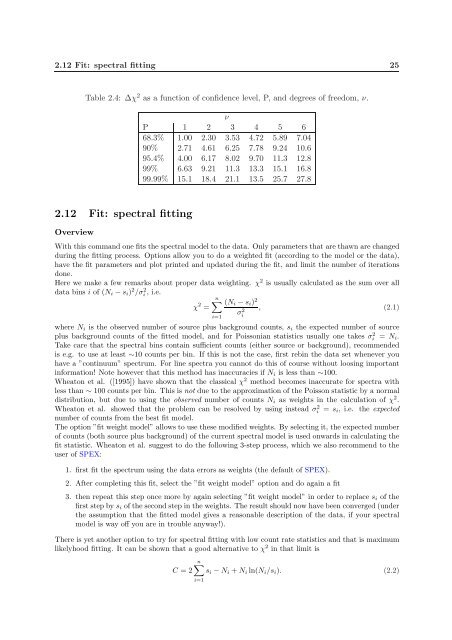SPEX User's Manual - SRON
SPEX User's Manual - SRON
SPEX User's Manual - SRON
You also want an ePaper? Increase the reach of your titles
YUMPU automatically turns print PDFs into web optimized ePapers that Google loves.
2.12 Fit: spectral fitting 25<br />
Table 2.4: ∆χ 2 as a function of confidence level, P, and degrees of freedom, ν.<br />
ν<br />
P 1 2 3 4 5 6<br />
68.3% 1.00 2.30 3.53 4.72 5.89 7.04<br />
90% 2.71 4.61 6.25 7.78 9.24 10.6<br />
95.4% 4.00 6.17 8.02 9.70 11.3 12.8<br />
99% 6.63 9.21 11.3 13.3 15.1 16.8<br />
99.99% 15.1 18.4 21.1 13.5 25.7 27.8<br />
2.12 Fit: spectral fitting<br />
Overview<br />
With this command one fits the spectral model to the data. Only parameters that are thawn are changed<br />
during the fitting process. Options allow you to do a weighted fit (according to the model or the data),<br />
have the fit parameters and plot printed and updated during the fit, and limit the number of iterations<br />
done.<br />
Here we make a few remarks about proper data weighting. χ 2 is usually calculated as the sum over all<br />
data bins i of (N i − s i ) 2 /σi 2, i.e. n∑<br />
χ 2 (N i − s i ) 2<br />
= , (2.1)<br />
i=1<br />
where N i is the observed number of source plus background counts, s i the expected number of source<br />
plus background counts of the fitted model, and for Poissonian statistics usually one takes σ 2 i = N i .<br />
Take care that the spectral bins contain sufficient counts (either source or background), recommended<br />
is e.g. to use at least ∼10 counts per bin. If this is not the case, first rebin the data set whenever you<br />
have a ”continuum” spectrum. For line spectra you cannot do this of course without loosing important<br />
information! Note however that this method has inaccuracies if N i is less than ∼100.<br />
Wheaton et al. ([1995]) have shown that the classical χ 2 method becomes inaccurate for spectra with<br />
less than ∼ 100 counts per bin. This is not due to the approximation of the Poisson statistic by a normal<br />
distribution, but due to using the observed number of counts N i as weights in the calculation of χ 2 .<br />
Wheaton et al. showed that the problem can be resolved by using instead σ 2 i = s i , i.e. the expected<br />
number of counts from the best fit model.<br />
The option ”fit weight model” allows to use these modified weights. By selecting it, the expected number<br />
of counts (both source plus background) of the current spectral model is used onwards in calculating the<br />
fit statistic. Wheaton et al. suggest to do the following 3-step process, which we also recommend to the<br />
user of <strong>SPEX</strong>:<br />
1. first fit the spectrum using the data errors as weights (the default of <strong>SPEX</strong>).<br />
2. After completing this fit, select the ”fit weight model” option and do again a fit<br />
3. then repeat this step once more by again selecting ”fit weight model” in order to replace s i of the<br />
first step by s i of the second step in the weights. The result should now have been converged (under<br />
the assumption that the fitted model gives a reasonable description of the data, if your spectral<br />
model is way off you are in trouble anyway!).<br />
There is yet another option to try for spectral fitting with low count rate statistics and that is maximum<br />
likelyhood fitting. It can be shown that a good alternative to χ 2 in that limit is<br />
C = 2<br />
σ 2 i<br />
n∑<br />
s i − N i + N i ln(N i /s i ). (2.2)<br />
i=1

















